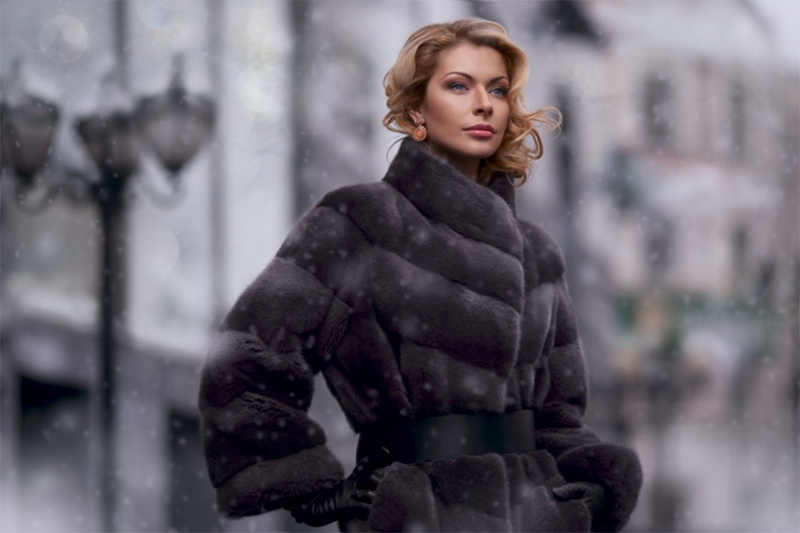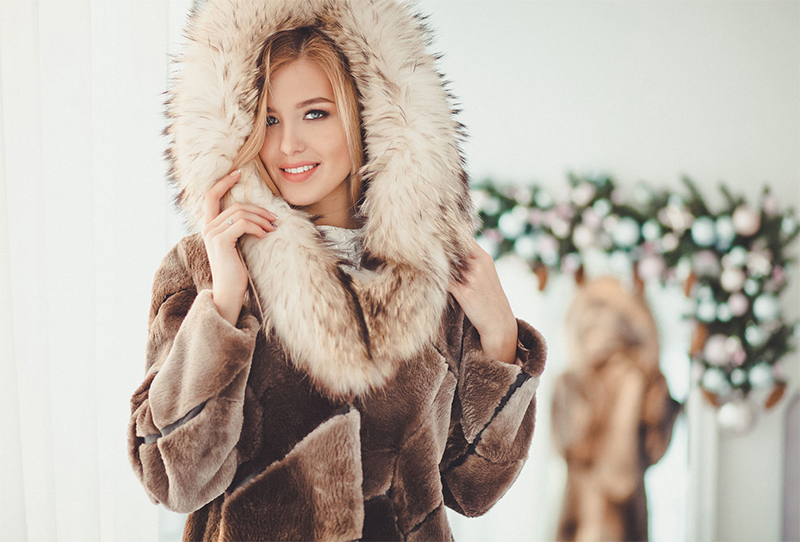The fur coat has long become something more than just clothing that helps to warm up in the student's time. In the modern world - it is a special symbol of wealth and status. Fur creations are placed on a par with cars, works of art, jewels or premium accessories. Fur coats are not just worn, they are appropriately looked after in order to extend the service life as long as possible. Since this thing is expensive, then its choice should be approached with all the responsibility. Our guide will help you decide among the variety presented in fur salons.

Content:
The best manufacturers of fur coats - which company to choose
Domestic and global markets are rich in fur-coat manufacturers in various price segments. There are sales leaders who manage to combine price and quality well. Such models are sold both here and abroad.
Especially popular among foreign companies are brands from Greece, Italy, Germany, Argentina. Russian brands are among the top, as the manufacture of fur products we have put on stream for a long time.
If you do not want to delve into the article, here are some of the most famous manufacturers:
- Elegant;
- Nitsa;
- Albertalli;
- Braschi;
- Roccabella.
These firms have the widest range of fur coats. The factories are selling not only classic models, but also many designer new products. The choice available can satisfy even the most demanding customers.
Their products meet all necessary standards, so it will last a long time. Those wishing to get acquainted with specific models, we recommend to go directly to our ranking of the best fur coats.
Fur coat structure

A fur coat is a product made from the fur of an animal. Designed to be worn in the cold, usually winter season.
The coats are not only warm and comfortable. Any woman, sometimes a man, wants to feel refined and elegant. Only natural fur can give this feeling. The more expensive the fur coat, the more exclusive the fur used to make it.
There are two common ways to sew a fur coat:
1. Use of the whole skin;
2. Use small pieces.
Of course, a product made of solid elements will look prettier and worn longer, but the cost, respectively, will also be higher. Fur coats from small pieces benefit in price, turning out to be a budget option for those who dreamed of making a purchase, but did not have sufficient funds.
A fur coat can have a completely different style:
1. Short or floor length;
2. With or without sleeves;
3. With a hood or collar;
4. With belt or free.
Types of fur coats
Mink

Fur coats from this famous fur are practical. Mink has a silky and soft cover, downy and guard hairs are well developed.
Fur, due to its softness, makes it possible to work with it when sewing not only fur coats, but also accessories, vests, jackets, skirts, etc. The properties vary greatly depending on where the breeding took place, what the climatic conditions and diet were .
Advantages:
- universality;
- keeps warm;
- average weight;
- serves up ten seasons.
Disadvantages:
- high price.
Sable

It is the pride of Russian manufacturers of fur coats. In terms of gloss, softness and color, this fur is considered the best in the world. Until now, despite the appearance of various technologies for cutting and coloring, designers use sable fur in its natural form. Often used to trim collars and other details on coats and redingots.
Advantages:
- retains heat well;
- looks presentable;
- maintains up to seven seasons.
Disadvantages:
- heavy;
- expensive.
Lynx

Rare species of wild fur. Scandinavian skins are particularly beautiful. Benchmarks are those on which black spots are more clearly visible.
When sewing, only the plates from the side parts are used, since they are the softest, have a light color and bright characteristic spots. The fur is almost never processed, so that the unique natural look is not disturbed.
Advantages:
- ideally keeps warm;
- a light weight;
- softness.
Disadvantages:
- lynx fur coats are rare for sale;
- more sable.
Fox and fox

Long fur types. Both are particularly fluffy. True, the fox is a bit heavier than the fox, but when sewing fur coats this is taken into account, so the models are made lightweight. The skin of the blue fox is famous for its unusual platinum color. The tips on the background of white down form a smoky veil that looks incredibly beautiful.
Advantages:
- both species retain heat well;
- serve up to six seasons;
- comfortable to wear.
Disadvantages:
- fox fur heavy
- blue fox is expensive.
Chinchilla

It is in the top three most prestigious furs. Weightless, it is great for sewing great fur coats. The structure is unique: a gentle down to 3 cm with a hair diameter of 14 microns. The color has two smooth transitions, from dark gray to bluish-gray and light white. It is precisely because of the special beauty, tenderness and softness that chinchilla products have a high price.
Advantages:
- a light weight;
- thick;
- warm;
- maintains up to five seasons.
Disadvantages:
- high price.
Rabbit

One of the most affordable furs. Although he does not have high levels of strength, he is able to withstand a couple of winters, with the affordable price he has - this is the optimal ratio. Designers love to make rabbit fur coats, as it is easy to experiment with it: to give unusual shapes, cut, dye, imitate more expensive furs.
Advantages:
- lightweight;
- inexpensive.
Disadvantages:
- serves up to two seasons;
- retains heat poorly.
Marten

Externally, marten resembles sable, but has a lower fur density. In Europe, where sables are not found, it is this beast that occupies its niche. In addition to fur coats and jackets, fur martens sew hats, trim cuffs, collars, etc. The wide color palette allows you to create unique products. Particularly popular is smoky gray and dark brown.
Advantages:
- very warm;
- serves up to seven seasons.
Disadvantages:
- heavy by weight;
- rough pile
Sheepskin

Very practical fur. Not only fur coats are made of it, but also sheepskin coats. This is a type of outerwear, when the fur is not outside, but inside the product, allowing it to better warm the wearer. Due to the fact that sheepskin is an inexpensive material, designers can experiment with it in different ways. Sometimes they create very interesting and unusual models.
Advantages:
- stand up to six seasons;
- easy to process;
- affordability.
Disadvantages:
- no sophistication.
Otter and Beaver

This fur is one of the most durable. At the same time, he is not afraid of wet weather, but, on the contrary, is made from her the most fluffy and attractive. Especially prized colors deep dark color.
Without processing, fur is considered masculine, as it has considerable weight. For women, the products are made easier with a loosening of the sharp guard lint. This work is manual and time consuming, so the cost of such fur coats is higher.
Advantages:
- serves up to twenty seasons;
- very warm;
- impermeability
Disadvantages:
- great weight.
Astrakhan

Fur is often dyed, so you can make models of the most different directions. Karakul will also be an ideal option for special-cut fur coats with an architectural cut. The smooth and short nap having characteristic curls is very attractive. In addition to fur coats, fur collars, cuffs, hats and much more are made of fur.
Advantages:
- perfectly preserves the shape;
- moderate severity;
- maintains up to seven seasons;
- acceptable cost.
Disadvantages:
- less warm.
Coat selection options

Quality of manufacture
1. It is necessary to look at the shine of fur and its softness. If these characteristics are missing, then the purchase is definitely worth giving up.
2. It is also important to look inside out. Manufacturers often leave in the lining of the place where you can check the inside of the fur coat. Remember that the back side should be a light color, in any case not yellow.
3. When stroking or trying to pull out the fur, if the product is of high quality, the hairs cannot climb.
4. Fur, characterized by elasticity, when holding a hand against the pile, quickly restore its original shape.
5. Fur coats that have extraneous odors, for example, rancid fat, cannot be acquired.
Length
1. People with magnificent forms should not choose fur coats to the floor, especially if they are from long-haired fur, for example, foxes, lynxes, beavers. It is best to prefer smooth or short-haired models with a length not lower than the middle of the calf.
2. Undersized should choose products to the knee or slightly higher.
3. Thin and tall can get most of the fur coats, of different cut, long-sex ones will look especially good and elegant, with the presence of a belt at the waist.
Colour
1. Light-haired are recommended all pastel shades and browns, as well as golden, exotic colors of fox and lynx skins. Black coats are best avoided, otherwise the outlines may acquire some sharpness.
2. Dark-haired, on the contrary, perfectly suit all deep and rich shades, including black ones. More colors will decorate them with a reddish, bluish and reddish sheen, but here it is necessary to take into account the skin tone.
Style
The main rule: a fur coat should not be small. Determine the convenience, walking in it and making the movements that you usually make. She can not pull forward or backward, as well as push in the collar, otherwise just selected the wrong model.
1. Small sizes should be customized to the maximum height and shape. Keep in mind that short products above the hips make a big emphasis on the waist, with the exception of models that initially emphasize its line.
2. Large sizes fit well on women with voluminous hips, but with an average bust. Especially suitable trapezoidal shapes, knee-length.
Which coat to choose

1. The most wear-resistant will be mink, sable, marten, astrakhan, otter and river beaver. The last two are still distinguished by their resistance to wet weather.
2. Choose products only with a shiny, soft and elastic fur, where the reverse side of the skin has a light color without yellowness.
3. Fur coats should not climb, even if you deliberately tried to pull it.
4. It is worth buying models that have no extraneous odors.
5. People with curvaceous should prefer smooth and sheared fur, where there is no excess volume and great length. Slim fit most fur coats.
6. Blondes should choose gentle and light tones, not darker than brown. Brunettes, on the contrary, are deep and rich, including black.
7. The fur coat should sit comfortably and be in size.
8. For thin models are needed, sitting on the figure, and the full fit trapezoidal styles with a length not lower than the knee or the middle of the calf.
How much is a fur coat

1. Fur coats of lynx, mink, sable and chinchilla are the most expensive. Depending on the manufacturer, country of breeding, model, their value can reach 1 million rubles or more.
2. Products from fox, polar fox, marten, otter and river beaver fall into the middle category. Taking into account the model and method of dressing, they can cost from 150 to 500 thousand rubles.
3. One of the most affordable will be fur coats made of rabbit, astrakhan and sheepskin. The price tag ranges from 50 - 100 thousand rubles.
It will be interesting to friends too







